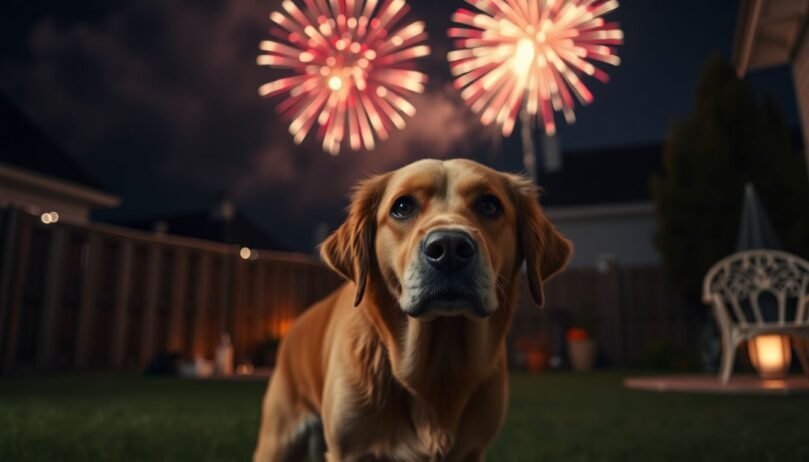How to Keep Your Dog Safe During Fireworks
- 22 January 2025
- BuyAPet Editorial Team
- All Dogs, Dog Health
Keeping Your Dog Safe During Fireworks: A Comprehensive Guide
Practical, vet-friendly steps to prevent panic, create a calm home setup, and handle emergencies—so your pup stays safe during fireworks.
🎆 For pet parents•Reading time: 6–8 mins
🧠 Understanding Your Dog’s Fear of Fireworks
The science of noise sensitivity
Loud, unpredictable bangs trigger a stress response—heart rate spikes, adrenaline releases, and the body shifts into “fight or flight.” Many owners report anxiety behaviours during loud events.
Recognising the signs of anxiety
- Shaking or trembling; tucked tail
- Excessive panting, pacing, or drooling
- Hiding under furniture, seeking small spaces
- Destructive behaviour (chewing, scratching) or attempts to escape
Example: Buddy trembles and hides behind the couch when fireworks start—classic fear signals that call for a calm plan.
Underlying conditions
Previous trauma, age-related hearing changes, or pain can worsen reactions. If anxiety seems severe or sudden, consult your veterinarian.
🏠 Creating a Safe & Secure Environment at Home
Den creation
Set up a quiet “safe room” or covered crate: comfy bedding, favourite toys, water, and long-lasting chews. Introduce it days in advance with treats so it feels positive.
Simple soundproofing
- Close curtains/blinds; hang heavier blankets over windows.
- Shut windows/doors; block gaps under doors with draft stoppers.
- Play soft music or white noise to mask external bangs.
Distraction & enrichment
Offer puzzle feeders, lick mats, or frozen stuffed Kongs to keep your dog busy and self-soothing.
🗓️ Preparing Your Dog in Advance for Fireworks
Desensitisation & counter-conditioning
- Play fireworks sounds at a very low volume while your dog relaxes.
- Feed treats/play calmly during the noise; end before any stress shows.
- Increase volume/duration gradually over days or weeks.
Behavioural support
A qualified behaviourist or positive-reinforcement trainer can build a tailored plan and coach timing, intensity, and rewards.
Medication & calming aids
For severe cases, talk to your vet about short-term anxiolytics or longer-term strategies. You can also discuss pheromone diffusers, compression garments, and nutraceuticals—evidence varies, so vet guidance helps.
🧭 Managing Your Dog During a Fireworks Display
- Stay calm: your dog reads your body language—speak softly and move slowly.
- Keep indoors: even well-trained dogs may bolt. Double-check doors, windows, and gates.
- ID & microchip: make sure tags are legible and microchip details are up to date.
- Leash safety: if outside, use a secure harness and lead; avoid off-lead walks at peak times.
🚑 Emergency Preparedness & First Aid
Spotting emergencies
- Escape attempts or a missing pet
- Injuries from panic (cuts, grazes, traffic exposure)
- Severe distress: nonstop pacing, vomiting, or collapse
Contacts & kit
- Keep vet and local emergency clinic numbers printed and in your phone.
- First-aid basics: saline, clean gauze, bandage, tick remover, muzzle/soft tie, torch.
Act fast: Clean minor wounds with saline and apply light pressure for bleeding. For serious injuries or breathing issues, call your vet/ER immediately.
✅ Conclusion: Keep Celebrations Dog-Safe
- Create a calm den and sound-buffer your home.
- Start desensitisation early; reward calm behaviour.
- Plan for ID, supervision, and emergencies.
Begin prep & desensitisation →
❓ Quick FAQs
- Should I comfort my dog or ignore them?
- Comforting calmly is fine—reassurance doesn’t reward fear. Keep your tone soft and movements relaxed.
- Do calming wraps and pheromones work?
- They help some dogs as part of a broader plan. Discuss options with your vet or behaviourist.
- Can I walk my dog during fireworks?
- Walk earlier in the day. If you must go out, use a secure harness and lead; avoid off-lead areas.
- How long does desensitisation take?
- Weeks to months depending on the dog. Start early and progress at a pace where your dog stays relaxed.
This guide is informational and not a substitute for personalised veterinary advice.
